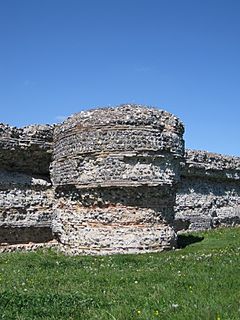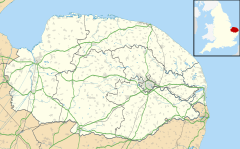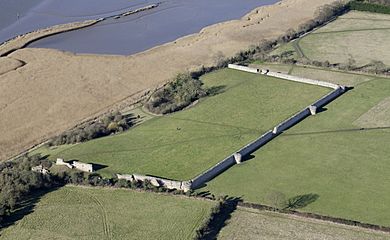Burgh Castle (Roman fortification) facts for kids
Quick facts for kids Burgh Castle Roman Site |
|
|---|---|
| Norfolk, England | |

A bastion on the eastern wall
|
|
| Coordinates | 52°34′57″N 1°39′05″E / 52.5826°N 1.6515°E |
| Grid reference | grid reference TG474045 |
| Type | Rectangular Roman Shore fort later Norman motte and bailey fort |
| Site information | |
| Owner | Norfolk Archaeological Trust and |
| Open to the public |
Yes |
| Condition | Roman fort: fair, surviving walls on 3 sides to 4.6 m (15 ft) high Norman fort: no remains |
| Site history | |
| Materials | Flint and some brick/tile |
Burgh Castle is an ancient Roman fort in England. It was built around 250 AD to protect the coast from Saxon raiders. The fort is located in Norfolk, on a hill overlooking what was once a large estuary.
Historians believe this fort might have been called Gariannonum by the Romans. After the Romans left, the site was possibly home to a monastery. Later, in the 11th and 12th centuries, a Norman motte and bailey castle was built here. Today, you can still see parts of the strong Roman walls.
Contents
What's in a Name?
The Roman name for Burgh Castle was likely Gariannonum. This name comes from an old Roman army list called the Notitia Dignitatum. It was written around 400 AD.
The name Burgh comes from an old English word, burh. This word meant a fortified town or a small castle. It's related to a word meaning "to keep safe." In German, the word Burg still means castle or fortress.
Exploring the Roman Fort
The Roman fort is shaped like a rectangle. It measures about 205 meters (670 feet) long and 100 meters (330 feet) wide. The walls on the north, east, and most of the south side are still standing. They are about 4.6 meters (15 feet) tall and up to 3 meters (10 feet) thick at the bottom.
The walls are made of flint stones and red tiles. They are built in alternating layers, making them very strong. Outside the walls, there are six solid, pear-shaped towers called bastions. These helped defend the fort.
The west wall of the fort has fallen away. It collapsed into what was once a wide estuary. Today, only Breydon Water remains of that estuary.
Archaeologists have found Roman coins and pottery at the site. These items show that the fort was used from the mid-200s AD until the early 400s AD.
A Possible Monastic Home
Some people believe Burgh Castle was the site of Cnobheresburg. This was an early Irish monastery founded in England around 630 AD by Saint Fursey. It was part of a mission to spread Christianity.
Archaeological digs in the late 1950s and early 1960s found some interesting things. They uncovered what might have been a timber church and a cemetery with many burials. They also found clusters of oval huts. These could have been living spaces or workshops for monks.
However, later studies have suggested there isn't enough clear proof for a monastery right inside the fort itself.
The Norman Castle
In the 11th and 12th centuries, a motte (a large mound) was built in the southwest corner of the Roman fort. The Roman fort walls were then used as the outer defenses, called a bailey.
The motte was later removed in the 1700s and 1800s. Digs have shown that a timber tower once stood on top of this mound.
Reusing Old Materials
The medieval church of St Peter and St Paul, located near the fort, uses Roman brick in its walls. These bricks were likely taken from the old Roman fort. This shows how people reused materials from ancient buildings.
In the 1600s, there was a local story that the fort had been occupied by "Jews." A path leading from the fort was even called "Jews' Way." This likely meant people saw the site as very old and mysterious. It also suggests the fort was used as a source of building materials.
Visiting Burgh Castle
Burgh Castle is located west of the village of Burgh Castle in Norfolk. It sits on the eastern bank of Breydon Water. This water body is where the rivers Bure, Yare, and Waveney meet.
The site is owned by the Norfolk Archaeological Trust. The walls are looked after by English Heritage. You can visit the site for free, and it is accessible for disabled visitors.
Burgh Castle in Stories
Burgh Castle has appeared in several fictional works:
- It's the Roman fort in the short story Interloper's Folly by S. A. Carr.
- It's one of the settings in the mystery novel A Pretty Deceit by Anna Lee Huber.
- You can see it in the video game Assassin's Creed Valhalla during a battle.
Images for kids
See also
 In Spanish: Burgh Castle (fortificación) para niños
In Spanish: Burgh Castle (fortificación) para niños










